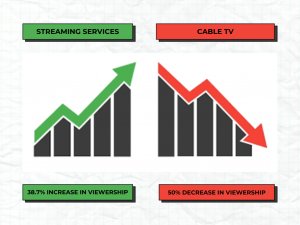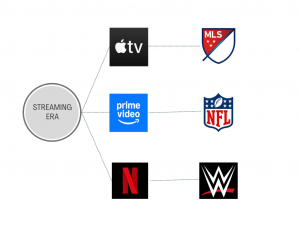In an era of digital evolution, the sports media landscape demonstrates a variety of realities that have come to bear. The interaction between sports media and consumers grows more complex as streaming services and social media become a new tool for consuming content. By navigating the interaction between the two, five realities of the industry are apparent.
5. Streaming Era of Sports

Over the last five years, sports have integrated with the reality of streaming services becoming a foundational tool for delivering content. According to Navigating the Shifting Sports Media Landscape: Trends and Recommendations, published in May 2024, by Sanjay Reddy, the landscape within the U.S. displays the transformation of TV consumption. Reddy reports how cable and broadcast television lost 50% of its viewership in the summer of 2023 while streaming services proceeded with a record growth of 38.7% in total TV consumption 1.

Moreover, the partnering of streaming platforms and sports organizations—Amazon Prime/NFL (National Football League), Apple TV/MLS (Major League Soccer), and Netflix/WWE (World Wrestling Entertainment)—illustrate a reshaping in the market structure of sports. The interactive market allows consumers to customize and filter their viewing experience while endorsing accessibility and globalization of sports content.
4. Shifting Attention Spans

Technological advancement grants an abundance of content for the world to engage with and suggest the attention of consumers becomes a scarce resource. In relation to New Media, Digitalization, and the Evolution of the Professional Sport Industry, published in May 2022, by Jingxuan Zheng, the article reports how Richard Ting, the Global Chief Design Office of R/GA, acknowledges that consumers’ attention spans are shattered pieces and sports are in competition with a variety of content across different platforms 2. The fragmentation of attention compels sports organizations to innovate how they leverage digital platforms to maintain relevance and grow engagement. The competition extends beyond traditional rivalry of different sports, but rather, encompasses a battle amongst social media trends and other interactive entertainment. Essentially, it reshapes how sports are consumed and marketed.
3. Collaborative Generation

The would of sports is expanding beyond the time restriction of a live sporting event. Today’s consumers engage with many platforms of social media like TikTok, YouTube, and X, to digest content. A 24/7 relationship with various forms of media, each of which is competing to garner the most attention, as consumers have more control than ever over what, when, where, how, and why they engage with content. The book, The Future of Sports Media: A New Reality, published in 2020, by Sam Duncan, reports how different age groups interact with sports-related content, “25-to 34-year-olds most commonly turn to ESPN (58%) and Facebook (52%), 13- to 24-year-olds are streaming video via YouTube (64%) and Snapchat (45%)” 3. Platforms like YouTube and Snapchat interact with a younger audience as a different variation of content. A younger generation is not only altering the model of time spent consuming content but is encouraged by the platforms to become creators. A generation of personalized content emphasizes the opportunity social media gives gans to reinvent and create their own videos and stories.
2. The Blurred Line Between Sports and Entertainment

The distinction between sports and entertainment has become increasingly blurred as media industries play a central role in this reality. As noted in Power Play: Sport, The Media, and Popular Culture, published in 2000, by Raymond Boyle, Sociologist John B. Thompson argues the relationship between sports and media, “Pop music, sports and other activities are largely sustained by the media industries, which are not merely involved in the transmission and financial support of pre-existing cultural forms, but also in the active transformation of these forms” 4. Media outlets seek to illustrate athletic competitions as cultural spectacles and market athletes as pop culture figures. Meanwhile, their incorporation of narrative-driven elements—rivalries, comebacks, or “underdog” stories—is the storytelling aspect of sports. Boyle identifies how traditional broadcast media played a role in sports coverage as a function of pop culture and entertainment. So, in a generation where streaming influences the globalization of sports and consumers have the tools to reinforce their perspective of what they are viewing, sports and entertainment continue to become synonymous.
1. What is a Sports Journalist?

In past generations, sports journalists were unchallenged facilitators of delivering information to fans. Despite being a primary draw of attention in the field of journalism, the coverage of sports doesn’t receive the same respect as others in this line of work. However, sports journalists are essential because of how big of a draw sports are with consumers. But, in the digital age of media, everyone is enabled to execute parts of journalists’ work of acquiring and distributing information online. Regardless of how certain fields of journalism are perceived, the existence of competition in the new landscape of media coverage is inevitable. Social media platforms, like X and YouTube, have democratized sports by allowing athletes, teams, and fans direct access to audiences without the need for traditional agents of communication. As different people embrace content creation, sports journalists face the challenge of maintaining ethical standards while embracing the interactive nature of digital storytelling. Essentially, they must wear multiple hats of being content creators, digital marketers, social media managers, and community builders. The balance between ethical investigation and entertainment has only grown more complex for sports journalists.
As the sports media ecosystem evolves, it reflects more than just a change in how content is consumed. The shift signals an intersection between culture, technology, and storytelling. The identity of sports is redefined through the rise of streaming platforms, fragmented attention spans, and interactive digital spaces. Today’s consumers are no longer passive viewers, but rather now can be curators, commentators, and even creators within the media they consume. For sports organizations, journalists, and fans alike, adapting to this dynamic environment is not just about keeping up. These realities implore a reimagination of what sports media can be in a digital-first world.
- Reddy, Sanjay. “Navigating the Shifting Sports Media Landscape: Trends and Recommendations.” Georgetown Law Technology Review, January 23, 2025. https://georgetownlawtechreview.org/navigating-the-shifting-sports-media-landscape-trends-and-recommendations/GLTR-05-2024/. ↵
- Zheng, Jingxuan, and Daniel S. Mason. “New Media, Digitalization, and the Evolution of the Professional Sport Industry.” Frontiers, May 23, 2022. https://www.frontiersin.org/journals/sports-and-active-living/articles/10.3389/fspor.2022.921329/full#B68. ↵
- Duncan, Sam. “THE FUTURE OF SPORTS MEDIA: A NEW REALITY.” In The Digital World of Sport: The Impact of Emerging Media on Sports News, Information and Journalism, 113–30. Anthem Press, 2020. https://doi.org/10.2307/j.ctv170x59d.11. ↵
- Boyle, Raymond, and Richard Haynes. “Sport, the Media and Popular Culture.” In Power Play: Sport, the Media and Popular Culture, 1–18. Edinburgh University Press, 2009. http://www.jstor.org/stable/10.3366/j.ctt1r20kn.5. ↵



5 comments
rmanzur
This article did a fantastic job capturing how rapidly sports media is evolving. I especially liked the breakdown of streaming, shifting attention spans, and how fans are becoming content creators themselves. The research and sources added depth, and the writing clearly connected culture, technology, and storytelling. It’s a smart and timely look at the future of sports media.
TJ
I appreciated how the article laid out the shift to streaming and its impact on sports viewership with clear data on lost cable audiences and streaming growth. The point about shorter attention spans really resonated, especially the stats on how different age groups choose platforms like YouTube or Snapchat. I also liked the discussion of how sports and entertainment blend together through storytelling and pop culture angles. Finally the look at how sports journalists must now juggle roles as creators and community builders felt especially spot on.
Micaella Sanchez
It is an interesting breakdown of not just sports, but also puts into perspective all media and how much it has changed with the way it is consumed. I know myself; I have not watched anything on cable since I was 13. I mainly use streaming services, especially for sports, because of the variety of different commentators available across different streaming services.
Carlos Flores
This article does a fantastic job capturing the evolving landscape of sports media! I really appreciate how clearly you broke down each major reality with strong examples and references. Your writing highlights not only the changes but also the exciting opportunities for both consumers and professionals. Congratulations on creating such a thoughtful, insightful, and well-organized piece—great work!
Meadow Ayala
This was such a fascinating breakdown of how much the sports media world has changed. It’s amazing — and a little overwhelming — to realize how much technology has shifted not just how we watch sports, but how we interact with them on a personal level. I loved how you explained the blending of entertainment, culture, and storytelling. It really made me think about how today, fans aren’t just spectators anymore — they’re part of the story too. The way sports journalists now have to juggle so many roles just shows how fast this world is evolving. This article captured that reality so well!